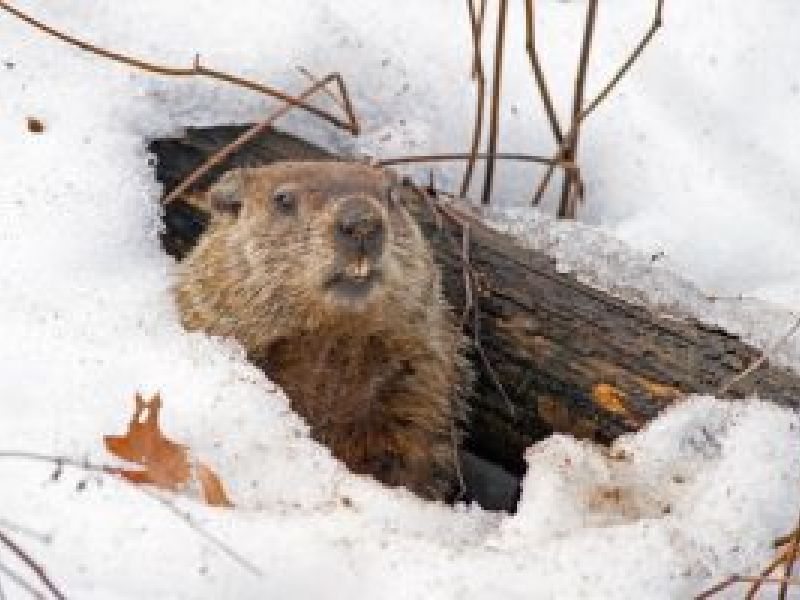News: Happy Groundhog Day & Hedgehog Day From Stikins ® Name Tags

As today is Groundhog Day and Hedgehog day, we've decided to celebrate gifted groundhogs and humble hedgehogs everywhere with a few fascinating facts about both!
What are the origins of Groundhog Day?
Now, we’ve probably all seen the classic 90’s movie “Groundhog Day” starring Bill Murray but did you know that most people don’t actually know the origins of the famous celebration? Well, Groundhog Day’s origins actually lie in the midst of overlapping ancient European weather lore, pagan and Christian festivals, and cult worship…
- Imbolc (1st February): This is a pagan festival which marks the mid-point between the winter solstice and the spring equinox. The arrival of spring is celebrated by lighting fires and candles; traditionally, Cailleach (a weather deity) will make Imbolc a sunny day if she needs to collect firewood for a longer winter, while serpents and badgers will emerge from their winter dens if there is to be an early spring.
- Brigid/Saint Brigid: Imbolc also celebrates the goddess Brigid; offerings are made in return for her blessing on homes and farms (to ensure an early spring and fertile land). It is also the Saint Day of Saint Brigid (possibly a Christianised version of the goddess), who is associated with perpetual sacred flames.
- Candlemas (2nd February): This festival of light marks the end of the Christmas season; traditional rhymes say that a sunny Candlemas Day means winter will continue, while a cloudy day means winter will end.
- Ancient European weather lore: The habits of burrowing or hibernating animals were observed to predict a long winter or an early spring.
- Cult worship of bears: The emergence of bears from their dens would indicate the arrival of spring.
- Februa/Lupercalia (15th February): These Roman festivals of “Purification” or “Purging” were a form of spring cleansing ritual to drive out evil spirits and purify the city of Rome. February 5th was also an important date for weather divination.
According to one origin story, ancient beliefs merged as Roman legions travelled across Europe, leading to the creation of an ancient German proverb, which says that if a hedgehog sees his shadow at Candlemas, he will return to his winter den for another six weeks. This tradition arrived in the US with German settlers who had to replace the non-native hedgehog with another creature – the groundhog!
Where is the largest Groundhog Day Celebration?
The largest Groundhog Day celebration is held in Punxsutawney, Pennsylvania, where the annual prediction is made by Punxsutawney Phil – “Seer of Seers, Sage of Sages, Prognosticator of Prognosticators and Weather Prophet Extraordinary”. Phil is 131 years old (thanks to a special “elixir of life” he drinks each summer at the Groundhog Picnic) and spends most of the year living in the town library with his groundhog wife, Phyllis. At 7:25am (ish), Phil emerges from a special burrow to make his prediction (in “Groundhogese”) to the President of the Groundhog Club’s “Inner Circle”. The Vice President then reads one of two pre-prepared scrolls; declaring six more weeks of winter (if Phil has seen his shadow) or an early spring. According to the Groundhog Club, Phil’s predictions are 100% accurate (according to official records his accuracy rate is 39%). Other predictive groundhogs include Wiarton Willie, Buckeye Chuck, General Beauregard Lee, Shubenacadie Sam, and Staten Island Chuck!
What are the origins of Hedgehog Day?
Hedgehog Day has slightly sadder origins; the day was introduced as a way to raise awareness about the dangers faced by hedgehogs – particularly in Britain where numbers are dropping rapidly due to a decline in suitable habitats. Land is being used up for intensive farming, buildings, and transport links – making it difficult for hedgehogs to find food and isolating them in places with further dangers (including traffic, rubbish, and higher populations of natural predators such as badgers). Hedgehog Day aims to educate people about ways they can make their homes and gardens more friendly to hedgehogs (such as putting out shallow dishes of water and hedgehog food – or meat-based wet dog/cat food – and creating safe spaces and small holes in fences).
What makes a Groundhog or Hedgehog happy?
Groundhogs (also known as woodchucks) belong to a group of ground squirrels known as marmots. They measure around 40-65cm long (including a 15cm tail) and are extremely good diggers with very powerful jaws. They are mostly herbivorous (eating wild grasses and other vegetation where available) although they occasionally eat grubs, grasshoppers, insects, and snails. Groundhogs warn each other about impending dangers by whistling(!) and popular nicknames for these creatures include groundpig, whistlepig, monax (a Native American name meaning “the digger”) – young groundhogs are called chucklings.
Hedgehogs share a distant ancestry with shrews and have evolved very little over the last 15 million years. There are seventeen different species and, like many other early mammals, they have adapted to a nocturnal lifestyle – although they have poor eyesight and rely heavily on their senses of hearing and smell. They have between 5000-7000 spines, which are hollow hairs stiffened by keratin; most hedgehogs use them defensively (by curling up in a ball) although others (especially desert hedgehogs) will ram intruders with their spines to drive them away. Hedgehogs are omnivorous (eating plants and small animals) and they communicate with each other through grunts, snuffles, squeals, and even sneezes. Hedgehog comes from the Middle English “heyg/hegge” meaning hedge and “hoge/hogge” meaning hog (due to their piglike snouts), although they are also called urchins, hedgepigs, and furze-pigs – baby hedgehogs are generally referred to as hoglets.
Stikins ® name tags & school uniforms – perfect together whatever the weather!
Like the humble little groundhog or the spiky little hedgehog, our school uniform name tags can withstand even the coldest weather conditions. What’s more, they are also specifically designed to withstand repeat trips to the washing machine. A perfect multipurpose labelling solution, our name tags simply stick on and stay on, whether you’re labelling items of clothing, books, stationery, lunch boxes, shoes or bags!
Measuring a discrete 30cm wide by 15mm – our name tags fit perfectly on the wash-care label of clothing and fabric items, onto the side wall or beneath the tongue of shoes, and onto personal items of all shapes and sizes. Despite their small size, they can hold vital information, such as a name and a phone number, in a bold and clear font.
Our stick on name tags have also been independently tested using the BS EN ISO6330 wash test procedure for 60 washes at 40 degrees. This means that they can be put through the washing machine time and time again – they’ll even survive in dishwashers, tumble driers, microwaves, and sinks so you can safely wash and dry all of your labelled items!
To find out more about our name tags, or to order your own pack today, please do not hesitate to contact our team today! Each name tag guarantees to survive through even the longest of winters and the earliest of springs!



